Experimental all-terrain vehicle Tritton Trench Crosser (UK)
The author of the original project of an all-terrain vehicle was William Tritton, a designer and specialist in the field of agricultural machinery. Subsequently, he will propose several other projects that will eventually lead to the emergence of the world's first combat-ready tanks. Moreover, together with Walter Wilson W. Tritton will be recognized as the inventor of the tank. However, before that there were a few more years, and engineers worked on other types of equipment. In the course of this work, several interesting projects appeared consecutively, within the framework of which various ideas of various kinds were tested. In particular, the goal of the Tritton Trench Crosser project was to study an original technique for crossing some obstacles. In fact, a promising machine was to become a technology demonstrator.
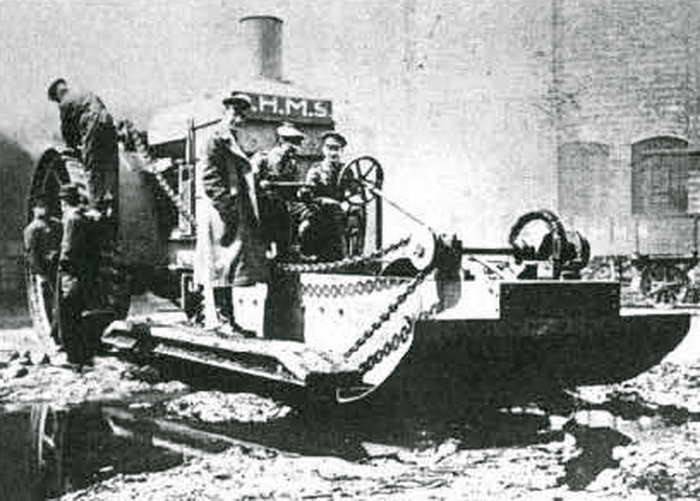
Experienced all-terrain vehicle Tritton Trench Crosser on trial. Photo Landships.activeboard.com
Prospective experienced machine had to cross the trench, which led to the appearance of the corresponding name. The proper name of the project Tritton Trench Crosser is translated exactly as “W. Tritton Trench Interceptor”. Other designations are not used.
As the basis for the all-terrain vehicle, the new model U. Tritton planned to take one of the existing tractors on a wheeled chassis. Such a machine was suitable for use as a prototype, necessary to test the original idea. In the future, however, certain changes could be made to the project. The use of a wheeled chassis, in contrast to the tracks, simplified the design of technology. At the same time, the patency of the wheels, including the large diameter, left much to be desired. For this reason, the author of the project decided that the wheeled chassis should be supplemented with some new devices.
One of the easiest and most obvious ways to cross a moat or trench is to lay a bridge of one kind or another. The plane laid over the trench, allows you to move through it without any restrictions on the type and characteristics of the chassis. It is this principle that the British engineer decided to use in his new project. It was proposed to move across the moats with the help of a special construction of the machine and a special bridge carried by it. For the interaction of the all-terrain vehicle and the portable bridge, a special system had to be developed.
As the basis for the experimental all-terrain vehicle, a Daimler-Foster serial wheeled tractor, equipped with a hp 105 petrol engine, was chosen. A number of such tractors were built shortly before the outbreak of World War I by Foster, commissioned by South American agricultural companies. However, due to the start of the war, all this equipment, distinguished by high characteristics, was requisitioned and handed over to the army. In the shortest possible time the tractors showed themselves well as towing vehicles for various trailers, weapons or special equipment. After the appearance of the proposal for authorship of U. Tritton, one of the available tractors was to become the basis for a prototype-technology demonstrator. To do this, it had to be significantly improved, removing some units and installing others.
In the initial configuration, the Daimler-Foster tractor was a two-axle vehicle with large-diameter rear wheels. In front of the rectangular frame, the engine was mounted in a characteristic case, behind it was a frame with tanks for fuel and water used in the cooling system. The back of the car was equipped with a control post with levers to monitor the operation of the power plant and the steering wheel associated with the front swivel wheels. Below the control post were some transmission units that connected the engine shaft to the axle axles of the rear wheels.
A characteristic feature of the Daimler-Foster tractors was the original power plant. Six-cylinder gasoline engine company "Daimler" power 105 hp housed in a high square casing. From above, the cover was closed with a cover in the form of a truncated pyramid, at the top of which a cylindrical tube was placed. This housing was one of the main parts of the original liquid cooling system. Heat was removed from the engine according to the cooling tower principle: the crankcase was piped with water through a pipe system, and the steam produced with the help of a suitable fan was discharged into the upper pipe.
To achieve high traction characteristics, the tractor received rear wheels with a diameter of 2,5 m. The wheels had a spit-shaped design, the bearing surface of the wheel was formed by curved metal sheets, equipped with large protrusions-grouser. The front wheels had a similar design, but differed by a smaller diameter and the absence of a grooved surface.
As part of the new project, it was proposed to remove some units from the base tractor and install new parts on it. Some changes had to undergo the frame of the machine, chassis and other systems. In particular, new course management tools have been developed. Also, the project provided for an original system that improved the machine’s permeability and allowed it to cross trenches.
In accordance with the project of W. Tritton, the base tractor was deprived of a front driven axle with small diameter wheels. Instead, the frame of the new construction should be fixed below the front of the frame. In its composition there were two longitudinal elements of great length and relatively large height. Top side added horizontal elements. At the rear of the additional frame, a small platform appeared to accommodate part of the crew and some controls.
The front cut of the vertical elements of the additional frame had a rounded shape. On this part of the frame it was proposed to mount a curved metal sheet with the required parameters of the plane, with which it was proposed to carry out the first stage of the ditch crossing procedure.
A horizontal transverse axis with two rollers at the ends was placed above the front sheet. In the middle part of the axis there was a gear wheel in contact with the worm. The latter was located on the long axis, which was brought to the front post of control and equipped with its own steering wheel. These devices were to be used to control the means of increasing the patency.
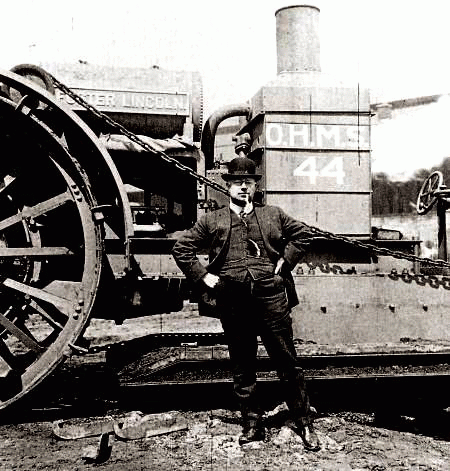
William Tritton on the background of an all-terrain vehicle of his own design. Photo Landships.activeboard.com
Directly behind the front curved sheet, U. Tritton proposed to position the axle with the front wheel of small diameter. Another similar wheel was placed under the front of the base tractor frame. According to some reports, the front wheels of the experimental all-terrain vehicle were driven. At the same time, however, there is no accurate data on control systems. Known information about the design of the machine suggests that it consisted of some drives to change the relative position of the frame of the tractor and the front of the unit, connected pivotally. This assumption is supported by the presence in the front wheelhouse of a horizontal steering wheel mounted on a vertical axis.
Also on the frame of the base tractor was asked to mount an additional feed unit. It was a horizontal structure with a triangular profile. On the back of this device was attached to the axis with two rollers for contact with the chains used in the system of increasing cross.
As planned by the author of the project, the Tritton Trench Crosser was supposed to cross the trenches using its own track bridge with a fairly simple design. The bridge was a device of two longitudinal beams connected by transverse elements. Each such beam had a rectangular shape and a certain height. The length of the beam was equal to 15 feet (4,5 m), width - 0,6 m. There were small ramps at the front and rear ends of the beams. The width of such a bridge corresponded to the rear wheel track: it was they who had to use this unit.
It was proposed to transport the bridge and prepare it for work using two chains of the appropriate length. A long chain was attached to each bridge beam, in its front and rear parts from the inside. The front part of the chain went forward and was put on the roller mounted on the corresponding axis. There the chain was bent and stretched to the roller mounted on the rear wheel arch. After that, the chain covered the roller of the rear axle and returned to the bridge beam. As part of the means of overcoming obstacles there were two chains and two sets of rollers for their tension.
To manage the experimental all-terrain vehicle had a crew of several people. Two were located on the ground in front of the engine and had to work with their own steering wheels. The horizontally placed wheel was responsible for maneuvering, and the tilted wheel was used to control the track bridge. The rear control post, located on the stern platform, was still equipped with controls for the gasoline engine and gearbox. There were no special operational requirements for the Tritton Trench Crosser, which made it possible not to pay attention to ease of operation, crew accommodation, etc.
William Tritton proposed an unusual way of crossing trenches that looked like this. The Trench Traveler should have approached the moat using a set of four wheels on three axles. Facing an obstacle, the crew had to slow down and slowly feed the front of the vehicle forward. Due to the specific distribution of the mass of the aggregates, the front frame could be easily hung over the moat and advanced. While continuing to move forward, the front wheels of the all-terrain vehicle could lose contact with the ground, however, the frontal sheet of the front frame had to reach the far edge of the trench and rest on it.
Having hung the car over the obstacle, the crew had to use one of the steering wheels of the front wheelhouse, with which the tension of the chains was relaxed. At the same time the track bridge departed from the frame and lowered to the edges of the pit, moving to the working position. Having laid the bridge, the driver of the Tritton Trench Crosser car could continue driving. In this case, the front wheels could once again lean on the ground, while the rear wheels drove across the bridge and then also fell to the ground.
Overcoming an obstacle, the crew had to drive a few meters, and then back up. It was necessary to remove the bridge from the trench, the subsequent passage through it in the opposite direction and return the device to its original position. Once under the all-terrain vehicle, the bridge was tightened with chains to the transport position. After that, the machine could continue to move to the next trench.
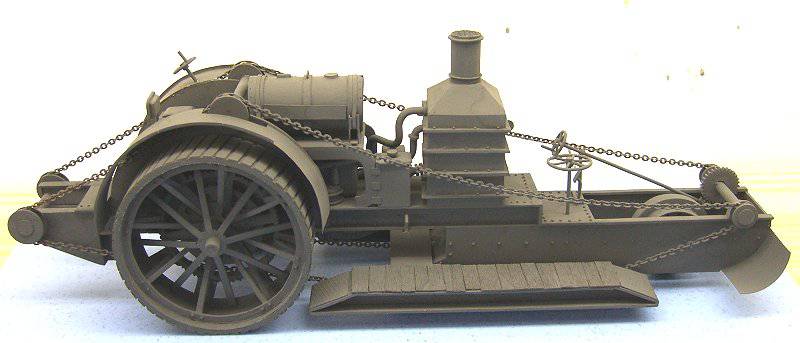
The modern layout of the Tritton Trench Crosser. Photo Moloch / Colleurs-de-plastique.com
The remaining schemes of all-terrain vehicle Tritton Trench Crosser allow us to estimate its size. The length of the machine reached 10 m, width - 2,8 m, height - about 4,4 m. The length of the track bridge was 4,5 m, rear wheels with a diameter of 2,5 m were used.
In the spring of 1915, an existing Daimler-Foster tractor was delivered to one of the British industrial plants, which was to become an experienced model of the Tritton Trench Crosser. Soon the tractor lost unnecessary units and received new devices, after which it was released for testing. The alteration of the car was completed in May of the same year, and checks were soon launched in the conditions of the landfill.
The task of the Tritton Construction Trench Cutter prototype was to check the original proposal for equipping the machinery with its own track bridge. For this reason, the prototype was tested on a site with several trenches of different widths. Testers quickly found that the all-terrain vehicle of W. Tritton was indeed capable of crossing the trenches at the expense of the original means of improving cross-country ability. Without any problems, the crew could move the nose of the car to the far edge of the moat, then lower the bridge and move over the obstacle.
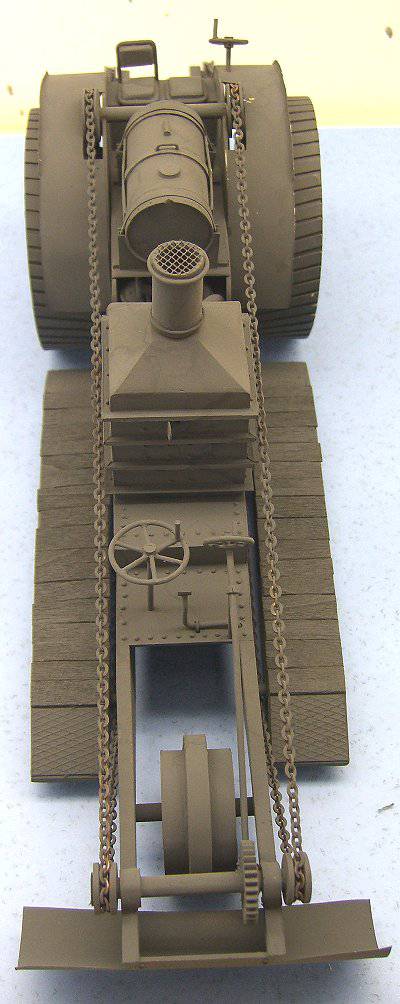
Model, front view from above. Photo Moloch / Colleurs-de-plastique.com
Nevertheless, in the course of the tests, obvious and serious project flaws were identified and confirmed. The trench crossing procedure was too long to be used in a combat situation. In addition, the proposed experimental machine was not distinguished by high maneuverability and mobility. It was hardly possible now to count on the continuation of the development of the project and the creation of an improved modification of the all-terrain vehicle adapted for use in the army.
Some sources mention the work on the formation of the possible appearance of a full-fledged combat vehicle based on the Tritton Trench Crosser all-terrain vehicle. In this case, all units had to be closed by a complex-shaped armored body. It was possible to change and increase the curved front sheet, providing the intersection of the ditches. Also in the front of the case could appear machine-gun. The track bridge, its chains and other devices necessary for improving the patency, remained outside the armored hull. This version of the project remained on the drawings.
During the tests, the original all-terrain vehicle confirmed its characteristics, but at the same time, showed all the flaws. In its current form, the machine could not be of interest from the point of view of future combat use. Further development of the project also did not make sense. After testing the prototype, the Tritton Trench Crosser project was closed for lack of prospects. Exact information about the fate of a single prototype is missing. Most likely, it was rebuilt into the tractor of the original model and returned to the old work, and all the original units were sent to junk.
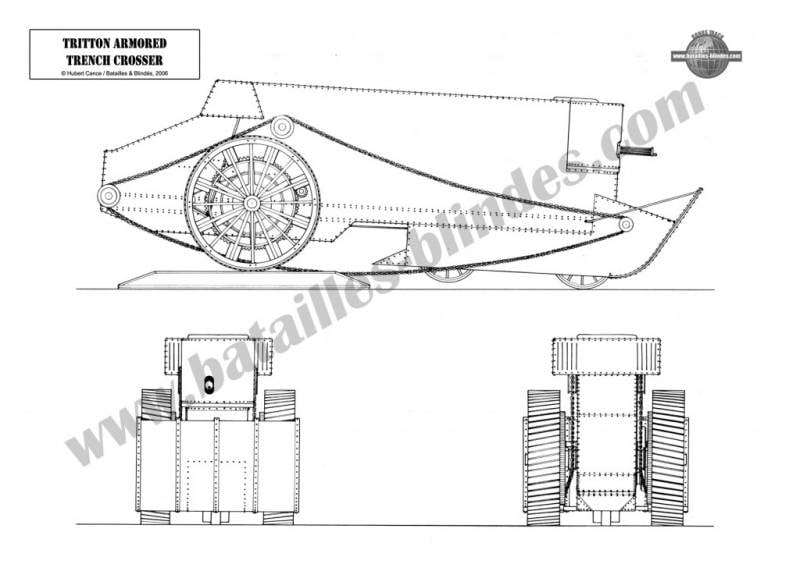
Option armored combat vehicle based on an experimental all-terrain vehicle. Figure Landships.activeboard.com
The unfortunate completion of the original project led to the emergence of relevant findings. The wheeled chassis, even when supplemented with a track bridge, had very limited prospects in the context of the future combat vehicles. Much more interesting were the tracked engines, the development of which was decided to continue in new projects. Already in 1916, these works led to the emergence of the first combat-ready tanks.
It should be noted that the idea of using the track bridges transported by self-propelled vehicles was further developed. Similar products really could facilitate overcoming of various obstacles of this or that equipment. However, for the most efficient use of the bridge had to be large and, consequently, be transported by a separate self-propelled machine. Similar ideas were subsequently implemented in the mass of so-called projects. tank bridge construction, the task of which is to install the appropriate engineering structures for use by other combat and auxiliary vehicles.
The Tritton Trench Crosser project was intended to test the original idea of increasing the maneuverability of the vehicle. Tests of a single prototype demonstrated both the performance and extremely low performance characteristics of the proposed equipment. Short trials allowed to determine the future development of military equipment, in time abandoning one of the obviously useless proposals.
On the materials of the sites:
http://landships.activeboard.com/
http://friends-of-the-lincoln-tank.co.uk/
http://armorama.com/
http://vikond65.livejournal.com/
http://shusharmor.livejournal.com/
http://justacarguy.blogspot.fr/
The process of making a model experimental rover:
http://colleurs-de-plastique.com/forums/showthread.php?10724-Tritton-Trench-Crosser
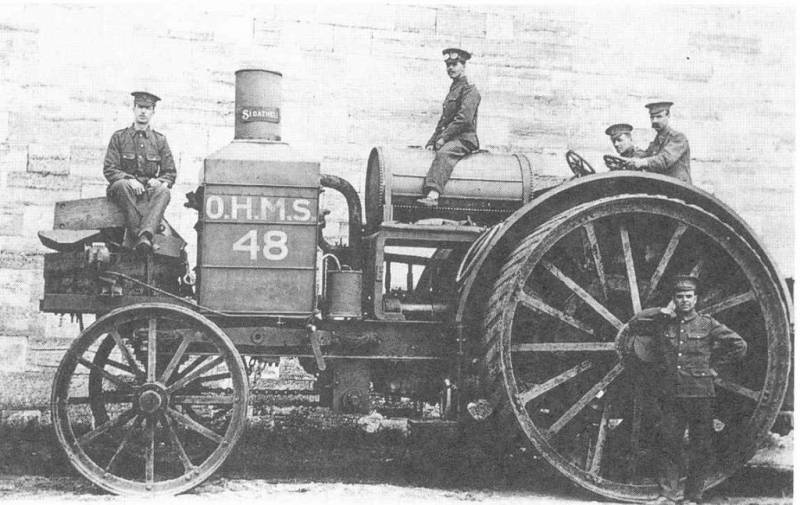
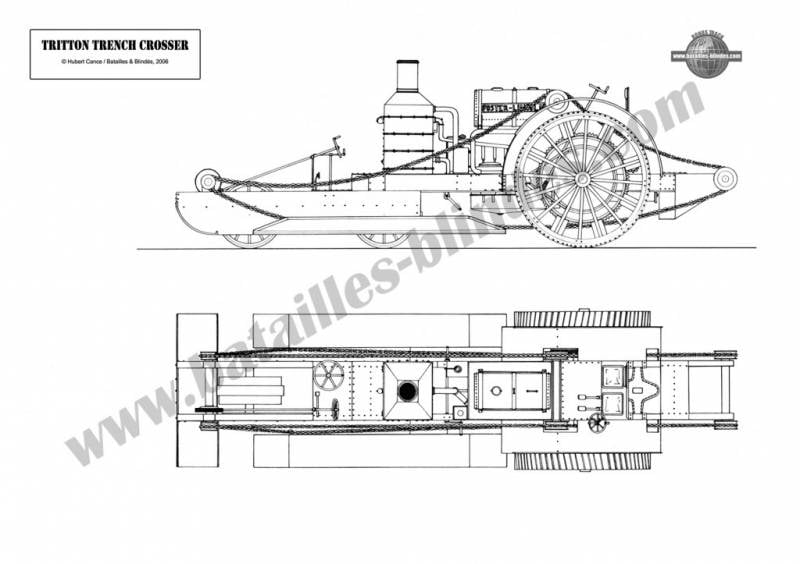
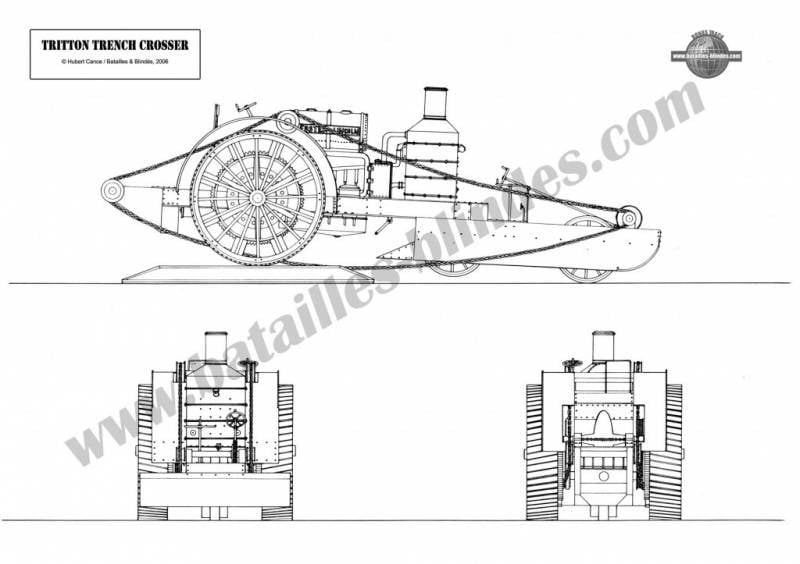
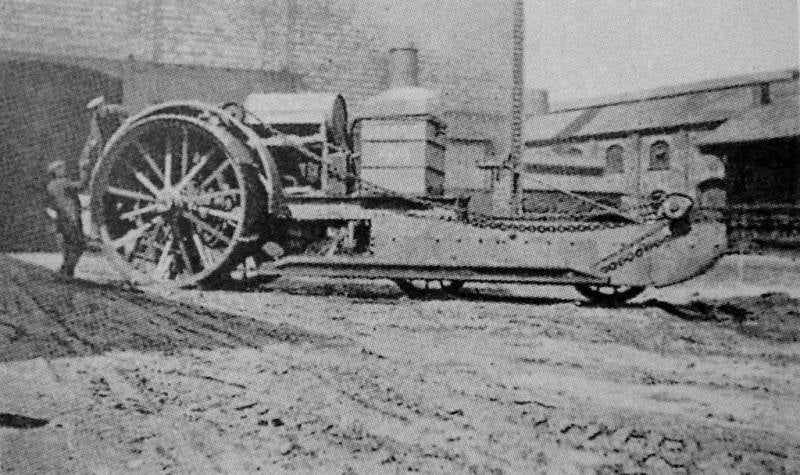
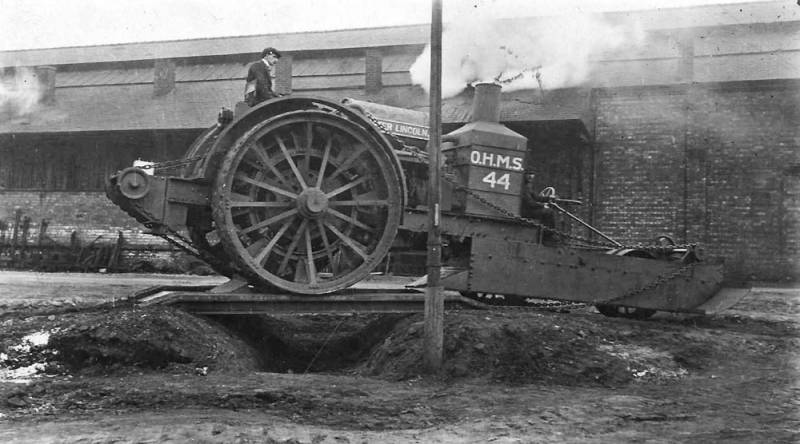
Information